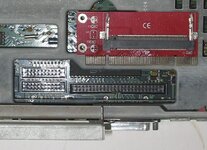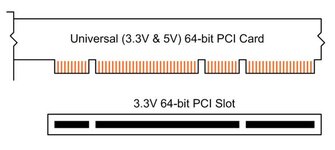Trash80toHP_Mini
NIGHT STALKER
Been playing around with reverse engineering boards here and there and something twisted up in my head this morning.
Inspiration would be the Radius Magic Bus™ setup for the SE with FPD and TPD cards:

Pie hole in the front is too constraining for reverse engineered boards headed into the Compact Mac form factor, so here goes:

Expansion chimney of SE/30 is unavailable for the SE so this is the PCB real estate required for implementing this connector:

View here is from front of machine, width is limited in the rear cutout for SCSI and FDD cables:
_ far left section unused as it fits on board but full length card is a few MM too wide for opening
_ plenty of contacts to divvy up any which way for matching up like signals of all three target Processor Direct Slots.
____ even more contacts available for PDS specific signals and a few spares for what-not
_ move SCSI and FDD DIP connectors to baseline card w/ prototyping area?
____ pads for bus transceivers would be provided on "stock" card with prototyping area like ISA ProtoBoards of yore
____ saves real estate on logic board and opens up a world of opportunities! }:-D
_ a pair of SCSI connectors go between controller and internal HDD connector
____ acts as internal cable with termination/switch on third connector up in lieu of HDD
____ offers ability to plug SCSI/SD/NIC implementations into new "SCSI riser" of sorts.
"Stock" baseline riser card required for SE board replacement, but that's no biggie for any such retro hack of Macintosh boards.
Front edge position leaves room on the logic board of SE for full SD card housed in printed external FDD D-Sub connector "SD slot." Traces for SD lead to the "stock" riser card's connections. With board's PCI-X connector mounted close to front edge of chimney, plenty of cubic remains for any kind of stock backplane breakout board I've seen to date.
SE/30 chassis implementation provides width necessary for full universal 64-bit PCI Card Connector and even more shenanigans.
Looking for feedback on how to best approach this. Suffice it to say that no stock Compact Mac boards are involved in this craziness. The only "original" Compact board would be the SE as it's in dire need of a PDS passthru for a VidCard when something nasty like a slot hog of an accelerator plugs up PDS and cuts off access to its single interrupt.
Inspiration would be the Radius Magic Bus™ setup for the SE with FPD and TPD cards:

Pie hole in the front is too constraining for reverse engineered boards headed into the Compact Mac form factor, so here goes:

Expansion chimney of SE/30 is unavailable for the SE so this is the PCB real estate required for implementing this connector:

View here is from front of machine, width is limited in the rear cutout for SCSI and FDD cables:
_ far left section unused as it fits on board but full length card is a few MM too wide for opening
_ plenty of contacts to divvy up any which way for matching up like signals of all three target Processor Direct Slots.
____ even more contacts available for PDS specific signals and a few spares for what-not
_ move SCSI and FDD DIP connectors to baseline card w/ prototyping area?
____ pads for bus transceivers would be provided on "stock" card with prototyping area like ISA ProtoBoards of yore
____ saves real estate on logic board and opens up a world of opportunities! }:-D
_ a pair of SCSI connectors go between controller and internal HDD connector
____ acts as internal cable with termination/switch on third connector up in lieu of HDD
____ offers ability to plug SCSI/SD/NIC implementations into new "SCSI riser" of sorts.
"Stock" baseline riser card required for SE board replacement, but that's no biggie for any such retro hack of Macintosh boards.
Front edge position leaves room on the logic board of SE for full SD card housed in printed external FDD D-Sub connector "SD slot." Traces for SD lead to the "stock" riser card's connections. With board's PCI-X connector mounted close to front edge of chimney, plenty of cubic remains for any kind of stock backplane breakout board I've seen to date.
SE/30 chassis implementation provides width necessary for full universal 64-bit PCI Card Connector and even more shenanigans.
Looking for feedback on how to best approach this. Suffice it to say that no stock Compact Mac boards are involved in this craziness. The only "original" Compact board would be the SE as it's in dire need of a PDS passthru for a VidCard when something nasty like a slot hog of an accelerator plugs up PDS and cuts off access to its single interrupt.
Last edited:
